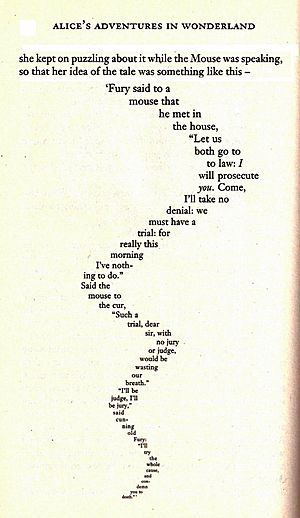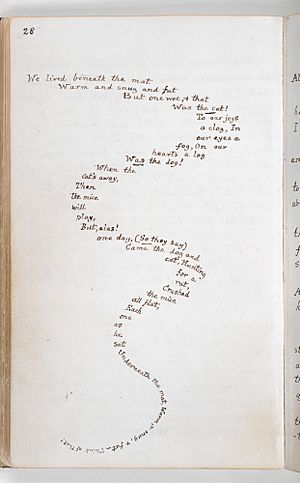The Mouse's Tale facts for kids
"The Mouse's Tale" is a special poem written by Lewis Carroll. You can find it in his famous book, Alice's Adventures in Wonderland, which came out in 1865. This poem is called a shaped poem because it looks like a mouse's tail. Even though the poem doesn't have a formal title in the book, the chapter it's in is called "A Long Tale." Also, the Mouse introduces it by saying, "Mine is a long and sad tale!" This shows the clever wordplay between "tale" (a story) and "tail" (what a mouse has).
Contents
The Story of the Mouse's Tale
In the third chapter of the story, a Mouse offers to tell Alice his life story. The Mouse starts by saying, "Mine is a long and a sad tale!" Alice gets confused. She thinks the Mouse means his actual tail, not a story. So, she imagines the poem looking like a twisted, tail-shaped drawing.
It is a long tail, certainly, ...but why do you call it sad?" And she kept on puzzling about it while the Mouse was speaking, so that her idea of the tale was something like this:—
In the poem, the Mouse talks about itself. It explains how a dog, called Fury, wants to put the Mouse on trial. Fury says he will be both the judge and the jury. He plans to decide the Mouse's fate all by himself. This part of the poem actually hints at the silly trial that happens at the very end of the Alice in Wonderland novel.
The poem goes like this:
"Fury said to a mouse, that he met in the house, 'Let us both go to law: I will prosecute you - Come, I'll take no denial; We must have a trial: For really this morning I've nothing to do.' Said the mouse to the cur, 'Such a trial, dear Sir, with no jury or judge, would be wasting our breath.' 'I'll be judge, I'll be jury,' Said cunning old Fury: 'I'll try the whole cause, and condemn you to death.'"
The Mouse says this "tale" will explain why he dislikes cats and dogs. However, in the printed poem, only a dog is the villain. There isn't a clear reason given for the Mouse's dislike of cats. But in an earlier, handwritten version of the story, called Alice's Adventures Under Ground, there was a different poem. That poem did include both cats and dogs as enemies of the mice.
How the Poem Looks
This poem is a very early example of what we now call a calligramme or concrete poem. Its shape adds to its meaning. It's not just shaped like a tail, but in the original handwritten version, the last words were even written upside-down!
Lewis Carroll himself decided how the poem would look in the first printed book. He made sure the letters got smaller as the poem went on. This makes the poem look even more like a mouse's tail, which gets thinner at the end. It's a pictogram because its shape shows something about its subject. A story told by a mouse is shown in the shape of a mouse's tail.
Later, some artists who illustrated the book made the "tale/tail" pun even clearer. For example, Willy Pogány put the poem right next to a drawing of a mouse in a 1929 edition. In Lisbeth Zwerger’s 1999 illustration, the words "Mine is a long and sad tale" are written right along the Mouse's tail.
In 1991, a student discovered that the poem actually had a "quadruple pun." Besides the "tale/tail" wordplay in the printed text, there were also visual jokes in the original handwritten version. When you look at the poem's traditional stanzas, the first two parts are shaped like a mouse's body. Short lines show its paws, and a longer third line forms the tail. Also, the type of rhyme used at the very end of the poem is called a tail-rhyme. This makes the last rhyme truly a "tail-rhyme," connecting the meaning and the shape.
Translating the Wordplay
Translating jokes, wordplay, and cultural references from one language to another is very hard. This is especially true when cultures are very different. Warren Weaver studied this in his book Alice in Many Tongues (1964). He looked at examples in 42 languages.
For instance, the Chinese translation from 1922 couldn't use the "tale/tail" pun. Instead, it cleverly played on the word for "sad." Since then, many studies have compared how different versions of the book in the same language, like Swedish, French, Polish, and Hungarian, handled these tricky parts.
Artistic Versions of the Poem
"The Mouse's Tale" has been turned into music and even a film.
- One of the earliest musical versions was in Liza Lehmann’s Nonsense songs from Alice in Wonderland (1908).
- György Ligeti used the text in his Nonsense Madrigals (1988–93).
- Rena Geli created a version for a small group of musicians and a female singer in 2003.
- Both the original and printed versions were set to music for a choir and piano by Bob Chilcott in 2015.
There has also been a short animated film of the poem made by Nada Harfoush in 2012.
|



